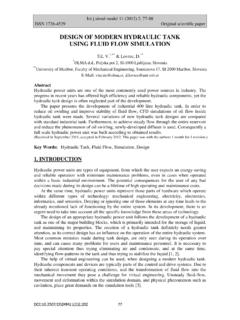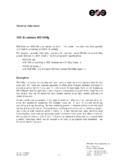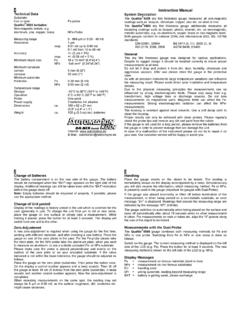Transcription of MODELLING AND SIMULATION OF SURFACE …
1 Int j simul model 12 (2013) 3, 141-153 ISSN 1726-4529 Original scientific paper (3) 141 MODELLING AND SIMULATION OF SURFACE roughness IN FACE MILLING Simunovic, G.; Simunovic, K. & Sari c, T. University of Osijek, Mechanical Engineering Faculty in Slavonski Brod, Trg I. Brlic Mazuranic 2, HR 35000 Slavonski Brod, Croatia E-Mail: Abstract The paper presents a research on machined SURFACE roughness in face milling of aluminium alloy on a low power cutting machine.
2 Based on the results of the central-composite plan of experiment with varying machining parameters (number of revolutions - spindle speed n, feed rate f and depth of cut a) and the roughness observed as output variable, two models have been developed: a regression model and a model based on the application of neural networks (NN model). The regression model (coefficient of determination of or adjusted) with insignificant lack of fit, provides a very good fit and can be used to predict roughness throughout the region of experimentation.
3 Likewise, the model based on the application of neural networks approximates well the experimental results with the level of RMS (Root Mean Square) error in the phase of validation of %. (Received in February 2012, accepted in March 2013. This paper was with the authors 4 months for 2 revisions.) Key Words: Face Milling, Central Composite Design, Regression, Neural Networks, MODELLING and SIMULATION 1. INTRODUCTION SURFACE quality of machined parts is often one of the most specified customer requirements and essential exploitation request where major significant indicator of SURFACE quality is SURFACE roughness .
4 The SURFACE roughness is affected by many controlled process parameters (including cutting speed, depth of cut and feed rate) and uncontrolled process parameters (cutting conditions, material properties of tool and workpiece, workpiece quality, tool geometry, tool machine vibrations, tool wear etc.) that are difficult to achieve and continuously monitor [1-7 ]. SURFACE quality, respectively SURFACE roughness , has an important influence on technological time and costs, i. e. productivity [8].
5 On this basis, many scientific-research projects and scientific papers of experimental investigations which are largely based on previously conducted and planned experiments aim at optimizing cutting parameters, MODELLING and predicting SURFACE roughness to obtain a desired level of SURFACE quality of machined products [9]. In this sense, many statistical (regression) models and models based on the application of artificial intelligence models have been developed. In paper [10] two MODELLING approaches, regression and Artificial Neural Network (ANN) are applied to predict minimum SURFACE roughness in the end milling machining process.
6 Both models predicted % lower values of roughness with regard to experimental values. In paper [11] the authors apply the same methods, and considering the input parameters of cutting speed, feed rate and depth of cut neural networks achieved better prediction of SURFACE roughness . After the previously conducted Taguchi plan of experiment, in paper [12] the authors developed different types of neural networks (radial base, feed forward and generalized regression) which evaluated SURFACE roughness after face milling of Al alloy 7075-T7351 based on input values (cutting speed, feed per tooth, axial depth of cut, chip s Simunovic, Simunovic, Saric: MODELLING and SIMULATION of SURFACE roughness in Face.)
7 142 width, and chip s thickness). The best results were achieved by the feed forward neural network. The investigation also showed that the SURFACE roughness was most affected by the chip thickness and cutting speed. Paper [13] deals with the SURFACE roughness MODELLING in accordance with the conducted full factorial design of experiments in end milling of AISI 1040 steel material with TiAlN solid carbide tools under wet conditions. ANN based on Back-propagation learning algorithm is used to develop the SURFACE roughness model.
8 With the support of NN and the application of genetic algorithms (GA) the optimization of the machining regime was performed resulting in the roughness reduction by nearly 12 %, the machining time by about 20 %, and the roughness prediction model proved applicable with an error of about 3 %. In papers [14-16] the authors model the SURFACE roughness in end-milling of 6061 aluminium. The authors in paper [14] carry out the machining with high speed steel (HSS) and carbide tools under dry and wet conditions and they have developed a mathematical model using response SURFACE methodology integrated with GAs.
9 In paper [15] the authors apply adaptive neuro-fuzzy inference system (ANFIS) and GA. The model input variables are the spindle speed, feed rate, depth of cut and the workpiece-tool vibration amplitude. The ANFIS with GAs are trained with a subset of experimental data. The obtained model is tested using the set of validation data (obtained by experiment). The results show improvement in comparison with the other soft computing techniques like genetic programming (GP) and ANN. The authors in [16] model SURFACE roughness by the application of multivariate regression analysis (MRA), ANN and ANFIS.
10 The model input variables are the same as in paper [15]. The results of all three methods are satisfactory but the test performance of ANFIS is better than ANN and MRA. In paper [17] the authors analyse the influence of cutting speed, feed, and depth of cut on SURFACE roughness in face milling process. For roughness MODELLING , based on the data collected by the planned experiment, they apply three methodologies: regression analysis, support vector machines and Bayesian neural network (BNN). All three models have the relative prediction error below 8 %.







